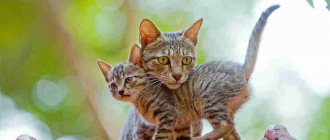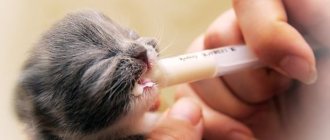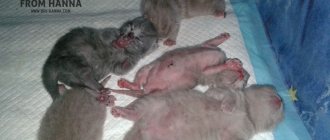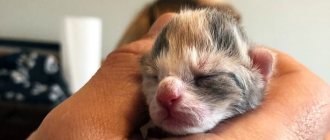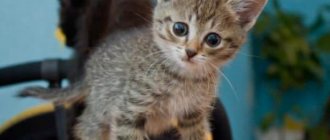The birth of kittens in a family is an amazing event. If your cat gives you offspring for the first time, then you are probably now trying to find answers to a lot of questions: how and whom to feed, how to help the mother cat, will she cope with raising children, will the newly born babies be able to become full-fledged cats and cats, how to check if they are healthy whether they and a host of others. This article will help you understand all the nuances of feeding and caring for cat babies and raising happy and healthy pets.
Newborn kittens
Giving birth to a cat: what to expect and how to prepare?
You can understand that your pet is preparing for childbirth by her behavior:
- the cat will become restless;
- the cat will often meow and caress;
- the cat will look for a suitable place to give birth.
In order for the birth to be comfortable, the cat looks for a suitable place in advance.
The pet will strive to find something warm and closed from prying eyes, which can be:
- cozy closet;
- dresser;
- a stack of clean bed linen.
In a word, anything – as long as it’s soft and warm. If you are not happy with the prospect of giving birth on clean and bright things, take care of creating a birth nest a couple of weeks before the birth - after all, the expectant mother will still need to get used to the new sleeping place.
Before giving birth, the cat will give signals with all its appearance
It is important that it be comfortable and free - after all, the cat will not only have to give birth in it, but also spend the next couple of months with her offspring - this is how long it would be desirable for the kittens to spend with their mother, because she will teach them everything that will be useful in their lives - starting from feeding and personal care, ending with the fact that if you jump on a chair after a person has gotten up from it, it will remain warm.
You can either buy a house for a cat or build it yourself - from boxes (just not from those where any chemicals are stored), plywood or wood and clean paper, newspapers, cotton fabric as filling. In addition to convenience, a maternity house must meet the following requirements:
- safety;
- purity;
- comfort.
If desired, a special maternity hospital for cats can be purchased
Safety
Both for the cat and for the kittens themselves. Firstly, the sides must be high enough (about 30 cm) so that the kittens cannot get out of there without permission, but at the same time the cat must freely leave and enter the house, without fear of crushing the kittens when jumping into the nest. It is equally important that other animals do not have access to the den - after all, they can harm the babies and bring infections that are extremely dangerous for the fragile cat’s immunity.
It is necessary to provide the cat with a comfortable and quiet place.
In addition, children should not be allowed to carry kittens in the first week of birth, and in general it is not recommended to touch babies unnecessarily - this makes the mother nervous and can provoke her to aggression towards her own children, interfere with the successful socialization of kittens among their brothers and increase the risk of infection babies with various viruses and infections.
Purity
Before giving birth, the house should be treated with a disinfectant that has absolutely no odor and covered with clean materials:
- paper;
- breathable fabric;
- newspapers, etc.
Important! The family's den should be located away from any strong odors and sounds - chemicals, garbage, detergents, noise and any irritating factors.
It is best to place a disposable diaper on the bottom of the bed
The bottom of the nest can be covered with a disposable diaper - it is convenient to change it daily. It is necessary to regularly clean the den because if there is blood and signs of childbirth, the cat will drag the kittens - after all, other predators can find them in nature by their smell.
Comfort
Considering that childbirth is a difficult matter, the mother in labor needs to be provided with the most comfortable conditions in the nest. It must meet the following requirements:
- be stable, otherwise the erratic movements of the kittens can knock over this nest;
- stay warm (but temperatures above 28ºC are harmful for both mother and babies, as they can cause overheating);
- do not come into contact with drafts.
The cat will be nervous if she has to lose sight of the kittens in order to go about her business, so it is better to move the feeder, water bowl and tray closer to the nest in advance. However, there is no need to put food and water in the house itself - it will be much easier for you to clean it when the cat leaves it.
The expectant mother must be provided with everything necessary
Development from month to year
Starting from this age, the gastrointestinal tract of kittens is actively developing; already in the eighth week, weaning from the mother occurs and the transition to independent food five times a day occurs. Deworming is carried out.
At three months, pets begin to look for a new owner. Parting with the mother and other kittens is not so painful if you devote enough time to the baby. Repeated deworming is carried out and the kitten is trained to use the tray.
Up to six months of age, the animal continues to eat kitten food. At six months, the pet’s teeth begin to change, and he is transferred to three meals a day. According to experts, this time is optimal for castration. The third deworming is performed.
At seven to eight months, cats continue to develop self-care skills. At nine months of age, the pet is considered fully formed; it continues to grow and gain weight. It is important to monitor the condition of the animal’s nails and cut them in a timely manner. During this period, they begin to gradually transfer the pet to food for adult cats, gradually mixing it into their usual food.
By the age of one year, the pet has completely completed its development. He is accustomed to go into a litter box or outside, has all the necessary skills of an adult animal, and has an established and formed diet. It is important to visit a veterinarian promptly for vaccinations and monitoring the health of your pet.
On the eve of childbirth
Usually a woman in labor copes with childbirth on her own, but a responsible owner should keep ready everything that may be useful during childbirth: clean towels, disposable diapers and gauze napkins, scissors and thick threads in case you have to cut the umbilical cord yourself, boiled water and a first aid kit, the contents of which should be discussed with your veterinarian in advance.
If your pet is constantly being observed by the same doctor, ask him for a phone number before giving birth in case of unforeseen circumstances or find contacts of a veterinary hospital where 24-hour consultation is available. Also make sure that you can go to the nearest veterinary clinic at any time, which is always open and you know the way to it and its exact address, in case you have to get there by taxi or on your own.
Childbirth is a moment of crisis for any cat and requires control from the owner
If a cat gives birth safely at home, she will eat the afterbirth after the kittens - this is absolutely normal. Some experts believe that it is enough to give the cat the afterbirth of only one kitten - especially if she has problems with the gastrointestinal tract. By the way, if the labor is long, then it is allowed to feed and water the woman in labor - this will give her strength. After giving birth, you need to clean the nest and leave the cat alone - she will have to carefully lick and feed each kitten.
By the way! More complete information on how to deliver a cat can be found in a separate article on our portal.
Caring for kittens
After a successful birth, a healthy mother is able to independently care for her babies: she gives them warmth, food, love and care. All the owner needs to do is to provide the nursing mother with adequate care and enhanced nutrition; many brands of cat food produce lines specializing in feeding pregnant and lactating cats.
After giving birth, a healthy cat can take care of her kittens on her own.
The main concern of a cat who has given birth is to feed each baby to its fullest, warm it up and lick it. When using the toilet, mother pays special attention to the tummy and anus area - this is necessary so that the babies can pee and poop, because they cannot yet do this on their own. The following table contains information regarding what you can and cannot do with newborn kittens.
Table 1. Rules for caring for newborn kittens
| Allowed | Forbidden |
| Take care of the cat and its offspring | Handle kittens unnecessarily |
| Feed a nursing cat heavily | Keep the family near strong lights, loud sounds and unpleasant odors |
| Keep mother and babies in a warm and safe space | Allowing children to pull kittens out of the nest, to irritate the cat, to make noise around a cat with kittens |
| Do not disturb either mother or babies, protect them from harsh light, sounds and smells | Feeding kittens cow's milk can cause diarrhea and various intestinal diseases, including incurable diseases. |
| Weigh all kittens at birth and every day for the first two weeks and record each kitten's weight in a chart. | Allow other animals to enter the nest and have contact with the kittens until they are one month old |
How does a kitten develop?
The kitten is born blind and helpless, but after six months he becomes an active and agile teenager, a small but well-armed predator with strong instincts that help him avoid danger and survive in a complex and unpredictable world. This magical transformation occurs according to certain laws: each new stage of life comes in its own time and leaves its mark on the character of the maturing cat.
This material has been prepared on the basis of many years of observations and serious research in the field of behavior problems in pets. We think that the facts that we present will help breeders properly organize the raising of kittens in nurseries, will provide valuable information to people with little experience, but who want to raise healthy and socially adapted kittens of their domestic cat, and will also teach everyone who wants to have a kitten to ask the right questions to the breeder and understand whether the baby grew up correctly in the nursery.
First month
The first month of a cat’s life can be compared to the first year of a child’s life [7]. The kitten goes from complete dependence on its mother to partial independence. By the end of this period, he is able to establish first contacts with the outside world. Some kittens open their eyes already on the second day after birth, others only on the 16th. Most often this occurs at one week of age. Kittens kept in a dark place open their eyes earlier than those raised in the light. A one-week-old kitten is already trying to walk - at first clumsily and cautiously, but after another two weeks he achieves mastery in this simple activity. By the end of the first month of life, the kitten begins to run [1].
During this period, the most important thing for him is his relationship with his mother. Brothers and sisters are now just competitors for food. The mother feeds and warms the kitten, and also helps it defecate by licking its tummy and the area around the anus. By the third week, the kitten learns to recover on its own, but the cat continues to help him until about 5 weeks of age [2].
A caring, calm, people-friendly mother is the key to the timely development and good character of the kitten. She teaches the kitten and punishes it by holding it with her back paw or hitting it on the nose with her front paw if he bites her too hard while flirting. Orphan kittens that are artificially fed have less control over their actions and may subsequently accidentally cause pain to their kitten or owner [4].
For the first three weeks of life, kittens receive only milk from their mother cat. In the fourth week, babies begin to get acquainted with “adult” food. If a cat is hunting, at this time she begins to bring prey to the nest, and the kittens remember the sight and smell of the prey. During this period, the cat is not constantly near the kittens, but prefers to watch them from a distance [1]. Regarding feeding, her tactics are also changing: she stops more and more often
not far from the kittens and waits for them to come up on their own.
If a cat's movements are limited, for example, by keeping her in a cramped cage with her cubs, the kittens begin to pester the cat with games. Her attitude towards them becomes less tolerant, and the kittens, imitating their mother in everything, also begin to play with each other more aggressively. Subsequently, this behavior is reinforced and becomes a character trait.
Second month
By the second month of life, the kitten becomes even more independent and leaves the nest for the first time. His communication skills are improving: he begins to communicate more and more with other kittens. During this period of life, he, in fact, turns into a representative of his species - he learns to communicate and hunt.
Towards the end of the first - beginning of the second month of life, kittens begin to play with each other. Gradually, the games become longer and longer and by the second month they turn into the cubs’ favorite pastime. In the game, they train their communication skills with their relatives and learn to understand the language of their species. During this period, kittens become strongly attached to their brothers and sisters. If a cat has only one kitten, it grows up more independent and is not afraid to be left alone. When there are several kittens, they behave more timidly: they are afraid to be alone and try to stay together.
Despite its importance for a child’s development, playing with relatives does not replace playing with objects, which should also have its place in his life. This is a completely special type of game - it helps to develop coordination of movements and a sense of space. In nature, these skills were necessary for a small predator to hunt [3].
Anyone who has newborn kittens in their home should know that at the age of two to seven weeks, babies go through a period of socialization, and humans are responsible for this process. At this time, the kitten needs to get acquainted with everything that will surround him in his later life [5]. Despite the fact that this period of socialization in cats is very short - much shorter than, for example, in dogs - it is especially “critical”. If the kitten spends these weeks in a poor, boring environment, without interacting with other cats or people, then it will be almost impossible to fill the gap in its development later.
Around the 7th week of life, kittens begin to perceive information about their relatives by the smell they leave behind. They carefully study the urine marks of other cats. At the same time, the “flehmen” reaction develops, when the kitten opens its mouth and wrinkles its nose. At this point, he analyzes the smell of urine using the vomeronasal organ, located inside the palate, which allows cats to learn about the maturity, readiness for mating, approximate age and health of their relative who left the mark [2].
From 2 to 6 months
Every day the kitten becomes more and more independent, and now the mother brings them half-dead prey for the first time. The sight of a prey running away makes a kitten
instinctive reaction - he jumps on a mouse or bird, but cannot always kill them. Then the mother intervenes. By imitating her and each other, the kittens learn everything that a predator should be able to do [3]. By 4 months they already accompany their mother on hunting trips.
From 6 months to a year
Adult cats perceive a six-month-old kitten as a teenager and, if they themselves had good social experience in childhood, treat him quite tolerantly. With the onset of puberty, the kitten moves from being an adolescent to the category of a young adult, and the attitude of its relatives towards it changes accordingly.
6–12 months of age is the age of separation from the mother and dispersal in young cats. A mother cat can maintain a friendly attitude towards her grown-up daughter for quite a long time and even show maternal care. She begins to reject her six-month-old son. In nature, this prevents inbreeding. However, if the space in which cats live is limited, and the son has nowhere to go, gradually the cat’s anger again gives way to mercy, and she can bring offspring from her son. In nature, this does not happen, since a young cat has to compete with older and battle-hardened males, and he begins breeding later, when he reaches not only sexual, but also mental maturity.
Nutrition
Insufficient nutrition of a cat in the second month of pregnancy and in the first weeks after birth, namely a lack of protein food, leads to a delay in the development of kittens: they open their eyes later, later they begin to crawl, run, play with relatives, poor coordination of movements prevents the development of hunting and play behavior , and all these disorders generally lead to difficulties in communicating with relatives [2].
Kittens grow up fearful and aggressive, it is difficult for them to get used to changes, any unexpected event plunges them into a state of shock [6]. Those who pick up a kitten on the street should be aware of these behavioral difficulties. Raising him to be a good companion may require more effort than with a domestic cat kitten. Interestingly, kittens aged 2–6 months easily imitate not only their mother and other cats, but also dogs if they live in the same house with them. They may try to accompany the owner and even learn some commands. It looks fantastic. I once trained a Yorkshire terrier puppy, teaching him for 20 minutes to come on command and sit at his owner's left leg. The young cat hung around all the time, trying to steal pieces of chicken that were used to reward the puppy. Having failed, the cat waited for the moment when the puppy did not comply with the command, jumped onto the floor, ran up to the owner and sat down exactly at her leg, like a well-trained shepherd dog. Need I say that he immediately received the desired delicacy?
Insulation
As we have already said, isolating a kitten at an early age leads to irreversible consequences. If a kitten is taken from its mother in the first days after birth, it grows up to be more aggressive. Lack of communication with relatives before 7 months leads to the development of fear of them, which will be all the more difficult to overcome, the more limited the kitten’s childhood experience. Isolation of a kitten from birth to one year has a negative effect on its nervous system; its rhythm of sleep and wakefulness is disrupted.
If a kitten is taken from its mother in the third or fourth week of life, that is, before it naturally and gradually begins to eat solid food, its hunting behavior will develop earlier and more strongly than usual. The same thing happens with orphaned kittens who are fed from a nipple.
Innate tendencies
A kitten's developing character is influenced by genetic predisposition, the conditions in which its mother cat was pregnant, and then the conditions in which the cub spent the first months of its life. According to their innate inclinations, cats can be divided into three groups: timid, aggressive and sociable [2]. These basic properties can be strengthened or weakened only to a certain extent, they remain the background for all subsequent layers of experience in the kitten's life.
Table of correspondence between the ages of cats and people
| Age of human kitten |
| 0–1 month 0–1 year |
| 2–3 months 2–4 years |
| 4 months 6–8 years |
| 6 months 10 years |
| 7 months 12 years |
| 12 months 15 years |
| 18 months 21 years old |
| 2 years 24 years |
References:
1. Crouwell-Davies S. Social behavior, communication and behavioral development in cats / Guide to behavioral medicine in dogs and cats. M.: Sofion, 2005
2. Overol K. Clinical methods for correcting the behavior of dogs and cats. M.: Sofion, 2005.
3. Caro TM Predatory behavior and social play in kittens // Behavior. 1981. V. 76, N?, 1-24
4. Casey RA, Bradshaw JWS The effects of additional socialization for kittens in a rescue center on their behavior and suitability as a pet // Applied Animal Behavior Science. 2008. V. 114, 196–205
5. Frank D., Dehasse J. Differential Diagnosis and Management of Human-Directed Aggression in Cats // Veterinary Clinics of North America: Small Animal Practice. 2003. V. 33, N 2, 269-286
6. Karsh EB: The effects of early handling on the development of social bonds between cats and people, in Katcher AH, Beck AM, (eds): New perspectives on our lives with companion animals. Philadelphia, University of Pennsylvania Press. 1983. 22-28
7. Reisner IR, Houpt KA, Erb HN, Quimby FW Friendliness to Humans and Defensive Aggression in Cats: The Influence of Handling and Paternity // Physiology & Behavior. 1994. V. 55, N6, 1119-1124
8. Vogt AH, Rodan I., Brown M., Brown S., Buffington CAT, Forman MJL, Neilson J., Sparkes A., Feline life stage guidelines // Journal of Feline Medicine and Surgery. 2010. V. 12, 43-54
The article was published in the magazine “My Friend Cat” No. 3, 2011
Thanks for the repost!
